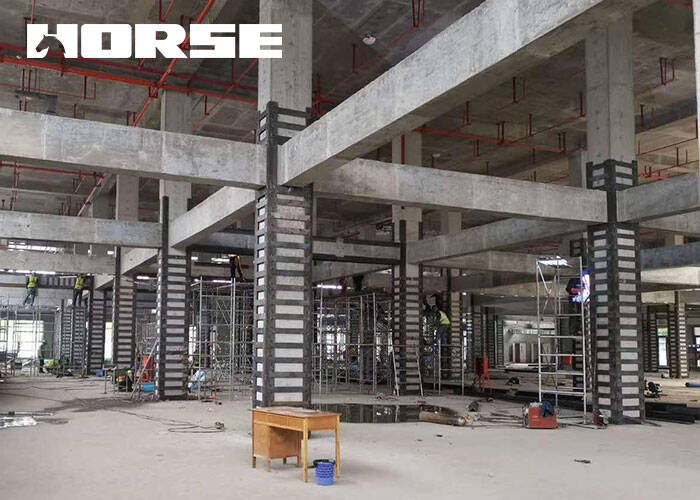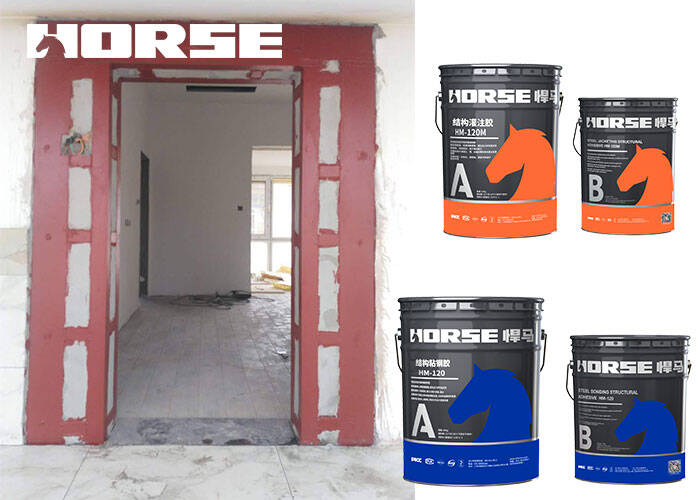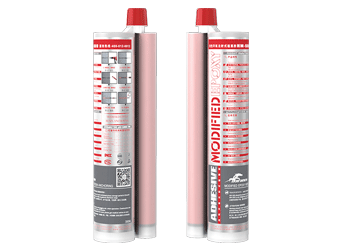Solutions
Horse Construction offers full range of structural strengthening materials with technical supports, documentation supports, products supports, project supports.
Problems to be paid attention to in strengthening concrete structures with bonded steel plate and steel jacketing

Problems to be paid attention to in strengthening concrete structures with bonded steel plate and steel jacketing
Glued steel plate reinforced shear wall door openings are mainly used to strengthen the tensile area of the component. The steel plate transmits shear stress and normal stress through the adhesive layer, and works with concrete to increase the bearing capacity. The concrete columns are reinforced with wet-clad steel. The concrete columns not only increase the bearing capacity, but also because the core concrete of the column is restrained by the steel hoop and slab, the ductility of the column is also improved.
1 Strength analysis of bonded (jacketing) steel reinforcement
The original structure in the reinforced structure has been loaded before the reinforcement, and the section stress generally reaches a certain level. For the reinforced components with insufficient bearing capacity, the stress level index is generally higher. However, the post-added part cannot work immediately after reinforcement, and only begins to receive the force when the second force is applied. During the second stress of the entire structure, the strain of the post-added part lags behind the strain of the original structure. How to make full use of the added materials and maximize its ultimate bearing capacity is a problem we should pay attention to.
Through the research on the flexural strength and rigidity of reinforced concrete beams with steel-bonded reinforcement, the tests carried out using structural glue and Q235 steel reinforced specimen beams are analyzed. The following issues should be considered in the design and construction
(1) In the design, appropriate quantitative analysis methods should be adopted. While considering the influence of the initial stress level on the material utilization coefficient, it should also consider whether the steel bars in the concrete before reinforcement yield.
(2) When using this method to reinforce concrete, it is more economical to use materials with a yield strain smaller than the ultimate strain of the original structure, which can give full play to the strength of the post-added material, thereby reducing or eliminating the stress hysteresis of the post-added material.
(3) Through partial unloading, the stress level index of the concrete before reinforcement can be controlled, which can eliminate the stress hysteresis, give full play to the strength of the added material, and reduce the waste of materials.

2 The safety of the adhesive
Bonded steel and wet-clad steel also have the safety problem of adhesives. There are also requirements for the measured concrete strength grade of the original structure and component base: it shall not be lower than C20 for important structures. The general structure shall not be lower than C15, because there is also a greater risk of peeling, which affects the actual effect of reinforcement. On the other hand, the actual quality also depends to a large extent on the properties of the adhesive and the construction process, and the safety of the adhesive is now mainly explained.
2.1 Performance of colloid
The bond strength is not only related to the adhesive force of the adhesive to the adherend, but also depends on the mechanical properties of the adhesive itself, and should not produce large shrinkage stress and microscopic defects. Mainly should be well controlled: tensile strength, flexural strength, compressive strength, tensile modulus of elasticity, ultimate elongation and other indicators.
2.2 Bonding performance
In application, the most important safety and quality feature is the adhesive strength of the adhesive in various ways. The bond strength is not only related to the glue type, adherend and its surface state, but also related to its bonding structure, geometric parameters, load and environment. It should be verified: steel-steel bond tensile strength, steel-steel bond shear strength, steel-concrete bond positive tensile strength, steel-steel uneven pull-off strength, steel-steel splitting strength, steel-steel impact strength, etc.
2.3 Durability
Performance Durability is a quality characteristic that an adhesive must have.
(1) Performance evaluation of resistance to stress persistence. For example: to evaluate the performance of modified epoxy adhesives under stress resistance of no less than 5000h.
(2) Performance evaluation under environmental resistance. It includes performance evaluation of resistance to damp heat aging and freeze-thaw cycle resistance.
You can find anything here you are in need of, have a trust trying on these products, you will find the big difference after that.

Two-component epoxy modified epoxy structural strengthening adhesive for bonded steel plate to concrete

Modified epoxy resin structural perfusion adhesive, specifically for supporting adhesive bonded steel reinforcement

Two-components modified epoxy resin adhesive, with high quality plastic tube, double cartridge package for anchoring